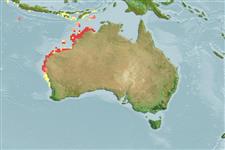Пластиножаберные (акулы и скаты) (sharks and rays) >
Orectolobiformes (Carpet sharks) >
Orectolobidae (Carpet or nurse sharks)
Etymology: Orectolobus: orektos (Gr.), stretched out; lobus (L.), from lobos (Gr.), rounded projection or protuberance, referring to long nasal barbels of Squalus barbatus (=O. maculatus). (See ETYFish); reticulatus: Latin for net-like or netted, referring to characteristic network pattern on dorsal surface. (See ETYFish).
More on authors: Last, Pogonoski & White.
Environment: milieu / climate zone / depth range / distribution range
экология
морской донно-пелагический; пределы глубины 0 - 20 m (Ref. 106604). Tropical
Indian and Western oceans of Australia.
Size / Вес / Возраст
Maturity: Lm ? range ? - ? cm
Max length : 52.3 cm TL (female)
Краткое описание
морфология | морфометрия
This small species (to at least 52.3 cm TL) has the following combination of characters: strong colour pattern with dark saddles, spots and fine reticulations; simple nasal barbel, thallate, without other lobes; poorly developed postspiracular lobes, the posterior postspiracular lobe (PS2) is simple, narrow or weakly thallate, and smaller than anterior postspiracular lobe (PS1); distance across preorbital group 1.3-1.6 times the interspace between preorbital group and anterior postspiracular lobe (PO/PO-PS1), 4.2-5.4 times base length of anterior postspiracular lobe (PO/PS1); base of the anterior postspiracular lobe 3.3-3.9 in its distance from postorbital group (PO-PS1/PS1), 1.5-2.1 in its distance from posterior postspiracular lobe (PS1-PS2/PS1); tubercle above eye prominent; wart-like tubercles absent on back; interorbital denticles are widely spaced, the anterior margins strongly crenulate; tall, upright dorsal fins; origin of first dorsal-fin over mid pelvic-fin base; interdorsal space 0.3-0.5 times the anal-fin base length; anal-fin inner margin 0.4-0.6 times its anal-fin posterior margin; about 21 tooth rows in upper jaw, no medial row at symphysis of upper jaw; 46-49monospondylous centra; 141-147 total vertebral centra (Ref. 76939).
No male adults are known, but a male adolescent, 50.3 cm TL (Ref. 76939).
Life cycle and mating behavior
половая зрелость | размножение | нерест | икра | Fecundity | личинки
Last, P.R., J.J. Pogonoski and W.T. White, 2008. Orectolobus reticulatus sp. nov., a new wobbegong shark (Orectolobiformes: Orectolobidae) from the continental shelf of Northeastern Australia. In Last, P.R., White, W.T. & Pogonoski, J.J. (eds.): Descriptions of New Australian Chondrichthyans. CSIRO Marine and Atmospheric Research Paper no. 22. (Ref. 76939)
Статус Красного Списка МСОП (Ref. 130435)
Угроза для людей
Harmless
Использование человеком
дополнительная информация
народные названиясинонимыобмен веществхищникиэкотоксикологияразмножениеполовая зрелостьнерестSpawning aggregationFecundityикраРазвитие икры
Возраст/РазмерыростЗависимость между длиной и массой телаЗависимость между длинамиРазмерный составморфометрияморфологияличинкидинамика численности личинокпополнениечисленностьBRUVS
ссылкиаквакультура (рыбоводство)особенности рыбоводствастепень растяжениягенетикаElectrophoresesнаследуемостьболезниобработкаNutrientsMass conversion
соавторыизображенияStamps, Coins Misc.звукиCiguateraскоростьтип плаванияжаберная областьOtolithsмозгзрение
инструменты
Специальные отчеты
Скачать в формате XML
ресурсы в Интернет
Estimates based on models
Phylogenetic diversity index (Ref.
82804): PD
50 = 0.5012 [Uniqueness, from 0.5 = low to 2.0 = high].
Bayesian length-weight: a=0.00389 (0.00180 - 0.00842), b=3.12 (2.94 - 3.30), in cm total length, based on all LWR estimates for this body shape (Ref.
93245).
Trophic level (Ref.
69278): 3.7 ±0.6 se; based on size and trophs of closest relatives
устойчивость к внешним воздействиям (Ref.
120179): низкий, минимальное время удвоения популяции 4.5-14 лет (Preliminary low fecundity).
Fishing Vulnerability (Ref.
59153): Moderate vulnerability (41 of 100).
